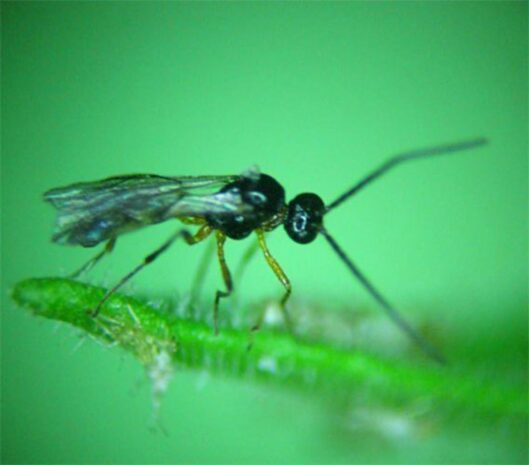Aphidius colemani is a solitary aphid koinobiont endoparasitoid and one of the most successful commercial biological control agents used in greenhouse crops. It is believed that this parasitoid wasp is of Indian or Pakistani origin. This wasp was first used in biological control programs in the early 1970s, and since 1991 it has been massively bred and sold commercially. Aphidius colemani is currently in use all over the world and is available from many commercial suppliers. A description of the morphological characteristics and life cycle of this species are as follows.
What is Aphidius colemani?
Aphidius colemani is a parasitic wasp, a local of North America that is useful for biological control of aphids in greenhouses and outdoors. These are very tiny, about 1/8 “or 2-3 mm long. Aphid parasites seek out aphid colonies to provide food and a place to reproduce. Adults Aphidius colemani responds to plant alarms to locate the aphids, where they feed on honeydew aphids’ secretions. Parasitism occurs when females lay eggs inside aphid nymphs.
Aphidius colemani has many positive qualities that often make it one of the first biological control agents introduced by manufacturers. Under ideal conditions, Aphidius colemani can maintain aphid populations at levels similar to those resulting from pesticide use, but it is safer and takes less time to apply.
Aphidius colemani Facts
The analysis shows that Aphidius colemani was discovered as a parasitoid of cereal aphids in Germany, which is likely due to the parasitoids’ accidental escape from the greenhouse and their successful overwintering and settling in the area.
Aphidius colemani is supplied as a parasitic aphid mummy, from which Aphidius colemani matures. This parasite can be used all year round in greenhouses and outdoors as it is not affected by short daylight hours.
The release rate is 500-3000 per acre, 2-3 times at intervals of one week, depending on the degree of infestation.
Aphidius colemani is used in greenhouses and has shown excellent ability to control aphid infestation.
When aphid populations are high, using Aphidius colemani alone does not provide adequate control, but they work well in combination with Aphidoletes to provide control. Efficacy may be reduced in late summer when natural hyperparasites may attack Colemani itself. These are even smaller parasitic wasps that parasitize both Coleman and aphids and appear instead of Coleman.
While this can be detrimental to the biocontrol program, modern processes can ensure that this is a rare situation. They are not sensitive to light. It prevents aphid populations from developing and reduces moderate populations to non-damaging levels. Packaged ventilation and food sources ensure adult survival during transport and storage.
Aphidius colemani Life Cycle
Female wasps of both species sting and inject one egg into the aphid. A single female can sting hundreds of aphids in her two-week life, although most of this parasite occurs in the first couple of days after she emerges. Once the egg hatches, the larva slowly eats the aphids from the inside. In 7 to 10 days, the nymph will be ready to pupate. He then kills the aphids and wraps them in silk, turning them into a “mummy.” From another week to 10 days, the pupating wasp completes its transformation into an adult and gnaws a round hole in the back of the aphid, from which it emerges. Adults are powerful flyers, and females travel long distances in search of aphids. They work best in temperature ranges of 64-75 ° F, although a few degrees higher or lower shouldn’t interfere with them. They are not affected by their short day length, so these aphids can be used all year round as long as the temperature is within acceptable limits.
Aphidius colemani Habitat
Aphidius colemani is a parasitoid wasp specializing in parasitizing the green peach aphid and the melon aphid or cotton aphid. This wasp is widely used in ornamental and greenhouse vegetable crops.
Aphidius colemani Identification
Aphidius colemani is a wonderful parasitic wasp that bites its prey with aphids and lays an egg right in the aphids.
The adult Aphidius Colemani is black in color with yellow legs. This parasitoid wasp has a long antennae and is about 2 mm long. After mating, the female lays eggs inside young or adult aphids. The larvae of Aphidius colemani grow inside them and feed on the internal organs of the aphid. After seven days, the aphid becomes immobile, swells, and turns beige. This stage is called the mother stage. A few days later, a new adult appears from the infected aphid.



